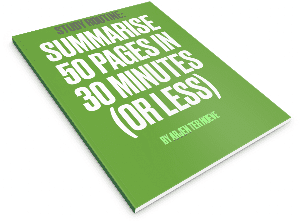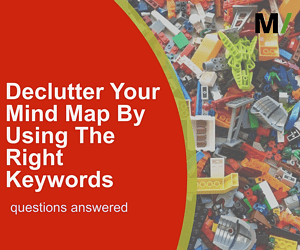Do you know that most mind maps don’t really benefit the person who makes them? The biggest reason for this is that the mind map is too cluttered with information.
Let’s have a look at what you can do to declutter your mind map. The result will be a map that helps you improve clarity and understanding.
Want to know how to do this? Here we go!
3 Ways To Declutter Your Mind Map
The mind maps of many people are overwhelming. They created maps that show so much information, you just want to use traditional notes again. How can a map that is so overwhelming benefit you?
To make sure you have a map that helps you, we have to start at the beginning.
Method 1: Only Use 1 Word (And The Notes Section)
Tony Buzan, the creator of the mind mapping method, already said this. Use only one keyword per node in your mind map. So instead of doing this:

You should do this:

Is that difficult to do? It probably is, especially in the beginning!
Does this mean that you will lose information? It might! I will not lie to you about that. Sometimes removing most of the information leads to less clarity. It may create stress!
This is no problem when you are mind mapping on a computer. You simply put all the extra information in a note tab!

On paper, things may be a little more difficult. You can do the same, it just takes a little more work. What you do is you take your original mind map, and create a new one based on it. In the new map, you only use one word per node.
You end up with a trimmed-down mind map, yet you still have the original map with all the text.
This first method wants you to go back to the basics of mind mapping. You use only one word per node. How do you find this word?
The best keyword to use in a node is the subject of that node. Be sure you are ‘brutal’ when you do this. Use just one keyword per node. Not three, not even two! Only use one word!
(you can always put all your information in the note section in your mind mapping software tool. On paper you can use the two mind maps method)
Method 2: The Google Method
You can use the previous method right now on your existing (or new) mind map. When I teach this to people, I notice that it makes them feel nervous or stressed. How can just one word help you understand or overview all your information?
I totally get that. I don’t like to use one word per node myself. That is why I go for a “minimal number of words” approach.
All I do is remove all the fluff from my text. What I end up with, is usually one to five words per node. Compared to one word per node, the map contains more information. But, I have a map that is much clearer.
(side note: leaving me guessing is not that much of a problem when you are studying. Thinking about what something means does not always happen, or all the time. You trigger your memory by going through such a map.)
How do you find the right keywords, you think?
For this, I use a technique I call “The Google Method“. Here’s how this works.
When you try to find an answer to a question using Google, what search terms do you use?
Most people don’t use full sentences with a question mark to get answers from the Google machine. You probably use a few keywords to find the best result in Google. Exactly those words are the ones that you should in your mind map.
Go over your mind map and take care of the large chunks of text. When you find one, ask yourself: What are the keywords that are the foundation of this content?
Put that information in your mind map.
Do you feel you do not have enough information? Add one or two more words. You should also familiarize yourself better with your map content.

Study Routine: Smart Summarizing
Method 3: Three Questions To Ask Yourself
Often people add too much information to a mind map because of insecurity. Does this sound like something you can relate to? Do you also (sometimes) add more information to a map because you feel you might miss something? Or perhaps you add information because you are not clear on where you are going with the map?
If that is the case, you should ask yourself this important question:
What is the purpose of this map?
A large map isn’t necessarily a bad map. There may be times when you have to add a lot of information. Going through a 50-page chapter may result in a large map.
Understand that the more you go through the map content, the less you need the map! You are getting more familiar with the content each time you study your information.
As long as you know WHY you create your map, you are moving forward. Studying the map results in smaller maps because you need less information.
So during the time you work with the map, you should ask yourself this question:
Do I really need this information in my mind map?
Things you know or understand may be removed or moved to the notes section. You can reduce the number of words on a node in your map. Remember the “Google Method” I talked about earlier?
Always… ALWAYS make sure you update your maps. The first map you create isn’t the final result of your mind mapping efforts. The first map is the beginning, the initial outline.
Over time, the map is updated. Information will be removed.
The result is a map that is cleaner and easier to go through.
Oh, while you remove information in your map, you should also think about this question…
Is this information in the right location?
That’s right, is the information still in the right location in your map?
You can remove nodes. But you should also check if you can regroup the nodes in your map to create a better outline. Dare to move nodes or even complete branches around in your map! You won’t be able to make a map that is “correct” from the beginning.
Your map will be changing over time. Information is removed. Information will be added. This means that you probably have to update the map structure to have a good outline of your information.
Action Tips For You To Use Right Now To Improve Your Maps
When you feel your maps can need a little makeover, use the three methods I write about above.
Go for a minimal number of words. Use the tab section in a mind mapping tool.
Ask yourself questions about the goal of the map and the necessity of the information. Put everything in the right place to create a good overview of your knowledge and thoughts.
What map will you be working on today? How can I help you?



